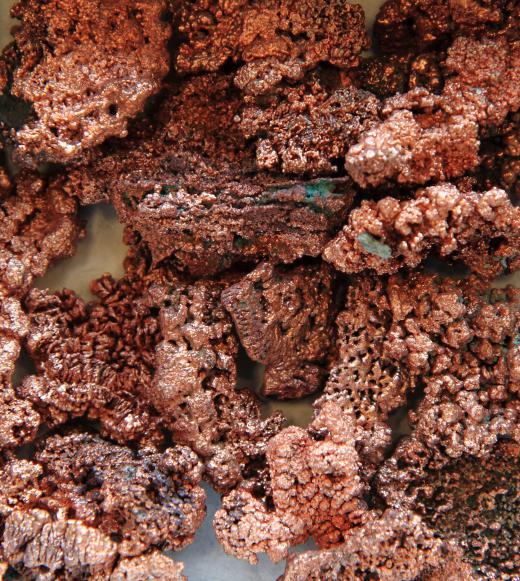At AboutMechanics, we're committed to delivering accurate, trustworthy information. Our expert-authored content is rigorously fact-checked and sourced from credible authorities. Discover how we uphold the highest standards in providing you with reliable knowledge.
What Is a Smelting Plant?
A smelting plant is an industrial location where metal is extracted for raw ore. Common examples of metal smelting include tin, lead, copper, bronze, and iron. The extraction of pure aluminum is also called smelting, although the process is significantly different from that of the other ores.
Metals begin their processing life as an ore. An ore is generally defined as a rock, or group of minerals, that has potential economic value. The ore does not contain only the metal of interest. For example, iron ore is a rock that contains iron bound up with other chemical compounds and minerals. Smelting ore is the process of removing the metal of interest from its original rock.

Smelting, as its sound perhaps suggests, involves partially melting the ore. The ore must be heated up in an oxidizing environment until the chemicals begin to mobilize or become available. Certain impurities can be driven off with heat, and if the metal of interest is in the form of a sulfide, heat and the presence of oxygen may be sufficient to convert it to an oxide. It is not possible, however, to simply melt the metal out of the ore.

In addition to heat, smelting also requires a reducing agent. The metal of interest likely exists as an oxide, or will be converted to an oxide during the initial heating. A strong enough reducing agent will be capable of converting the oxide to the pure metal and some waste product.
One of the early examples of a smelting plant was a bloomery, used by a blacksmith to smelt iron ore. Within a bloomery, iron ore is heated in the presence of charcoal, or pure carbon fuel, and moving air. As the ore is heated, the carbon monoxide from the charcoal reduces the iron oxide.

The smelting reaction within a bloomery produces a relatively pure iron metal, and carbon dioxide as a waste product. As the bellows blow through the bloomery, the carbon dioxide is evacuated, allowing the reaction to continue. The metal and impurities, called slag, fall to the bottom of the furnace as the iron ore is reduced. Typically, the iron is heated a second time to hammer out the slag from the now wrought iron.

Another early form of iron smelting is the blast furnace, which has a particularly ancient history in China. By the mid-1800s, however, iron ore was smelted into steel, which is a much more pure form of the iron metal. This industrial transition to making steel was made possible by the development of the Bessemer process, in which air blown through molten iron is able to remove most impurities. Beginning in 1950, the dominant method of extracting found in a given iron smelting plant became basic oxygen steelmaking (BOS). BOS improves upon the basic Bessemer process by blowing pure oxygen through the molten iron, which drastically improves the efficiency of the smelting plant.
Many other metals undergo smelting as a method of extraction, and many of the techniques of the various smelting plants and smelting equipment follow the same basic principles. Additionally, the extraction of aluminum is also called smelting. Aluminum smelting plants differ in that they are performing an electrolytic process. Electric current is passed through liquid molten cryolite, in which aluminum oxide has been dissolved. The corresponding oxidation and reduction that occurs at the electrical anode and cathode converts the aluminum oxide into pure aluminum.
AS FEATURED ON:
AS FEATURED ON:














Discuss this Article
Post your comments